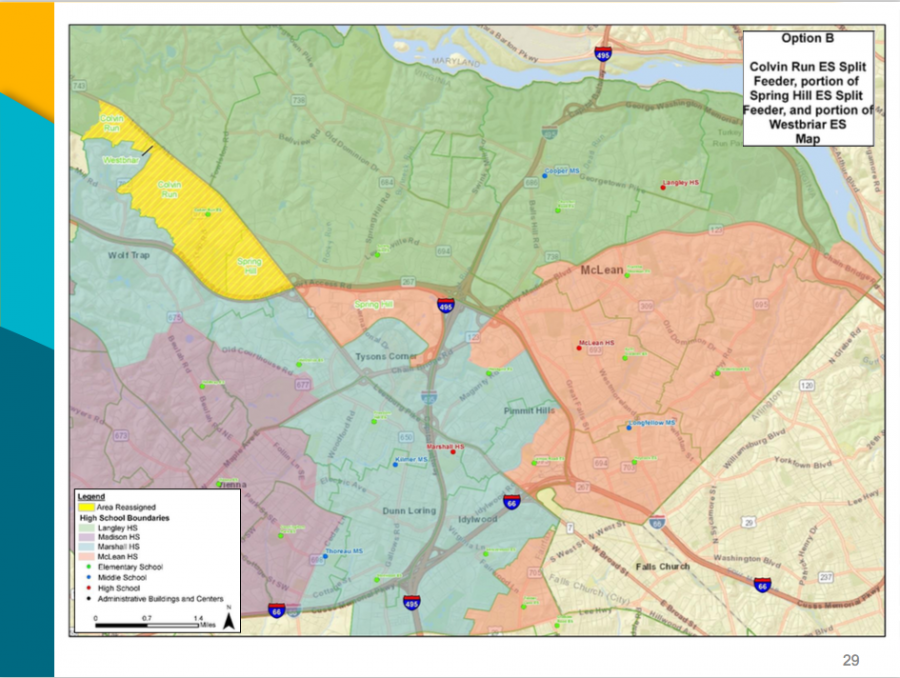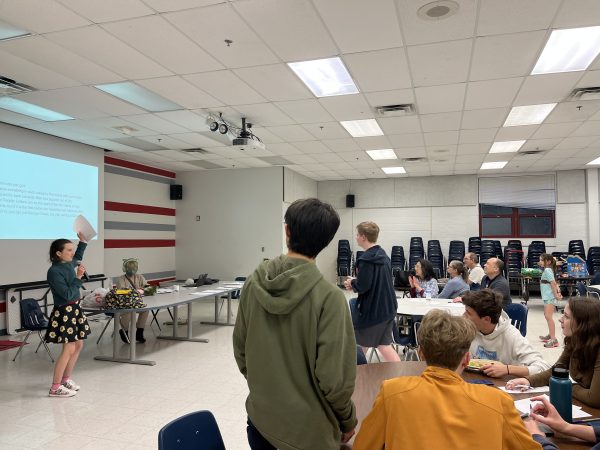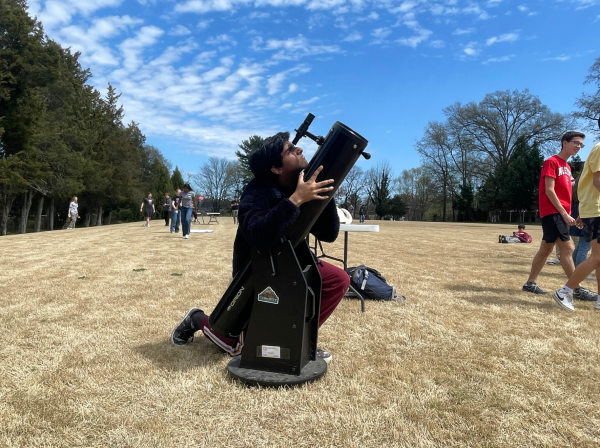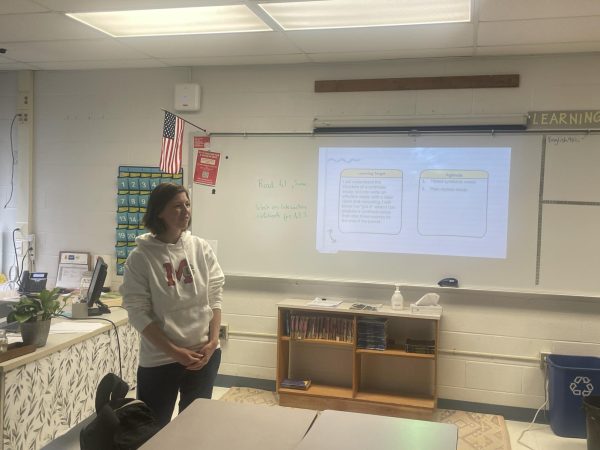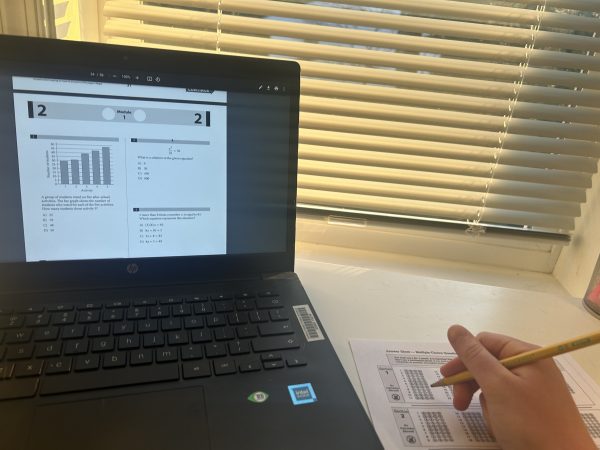Boundary changes to be implemented next school year
FCPS school board reaches a final decision on boundary adjustments
Image obtained via FCPS Boundary Study Presentation
A FINAL DECISION – In an eleven-to-one vote, the school board decided to implement Option B. The decision follows two years of community debate, and is set to take effect next school year.
After nearly two years of deliberation, the Fairfax County school board has finally determined how to proceed with boundary adjustments and redistricting plans. These changes will aim to redistribute the large number of incoming students at Longfellow Middle School and McLean High School through reassignment to Cooper Middle School and Langley High School, respectively.
With McLean High School currently at 118 percent capacity and Langley High School with room for nearly 400 additional students, the conversation surrounding boundary adjustments took priority this year. At a meeting on Feb. 4, the FCPS school board voted eleven to one to initiate changes associated with Option B.
“[Option B] would adjust the boundaries of McLean High School, Langley High School, Longfellow Middle School and Cooper Middle School,” Dranesville district representative Elaine Tholen said. “The change would adjust the feeder pattern of the Colvin Run Elementary School split feeder area, a portion of the Spring Hill Elementary School split feeder area and a portion of the West Briar Elementary School split feeder area.”
Tholen stressed that elementary school boundaries would not change as a result of the adjustment. She also laid out a plan for affected students, referring to ‘grandfathering’, a method that would spare current middle and high school students from reassignment.
“Rising seventh-grade students will attend Cooper Middle School [with] rising eighth-graders grandfathered to remain at Longfellow Middle School in the 2021-2022 school year,” Tholen said. “Rising sophomores, juniors and seniors in the area will be grandfathered and remain at McLean High School. The high school boundary change will begin with rising freshmen in the 2021-2022 school year.”
Following the board’s final vote on the adjustment, Elaine Tholen made a somewhat unprecedented addition to her motion. She urged the board to make an exception for rising freshmen, who she argued were hit especially hard this school year. Aside from coronavirus restrictions, changing boundaries, and virtual learning, eight-grade students were subject to changes in the TJ admissions system.
“[In] a nod to the hardships our Longfellow eighth-graders are undergoing this year, I would like to move that rising ninth-graders residing in the area of change will have the option to attend Langley High School or be grandfathered at McLean High School with transportation provided through twelfth-grade in the 2024-2025 school year,” Tholen said.
Both motions amassed widespread support, with the new adjustments scheduled to take effect in the 2021-2022 school year. Even so, the decision sparked controversy.
According to the boundary study data collected by the county, Option B will reassign about 190 students to Langley High School, while around 78 students will move to Cooper Middle School. However, the plan is only expected to reduce capacity at McLean to 95 percent by the next school year, which left some questioning its long-term effectiveness.
“I can’t reconcile not finding ourselves here five years later in the same place because we didn’t make the best adjustment we could have,” school board member-at-large Abrar Omeish said. “We know that the Tysons area is one of the fastest-growing development areas. That whole region is exploding, and if we look at the trends, I don’t feel that [Option B] is the most long-term solution.”
Despite sharing similar concerns, many parents agreed that Option B was the best of the three proposed solutions.
“Option B would address the board’s priorities and also reflect the preferences of several parents and families,” one parent said at the community meeting on Jan. 28. “It would [also] extend international diversity, as about half of [the] homes in our neighborhood are of international origin and multilingual households.”
In general, parents defended the change, citing both the geographical and social benefits of Option B.
“My daughter realized that she’s the only one [of] her elementary school friends that will be going to Longfellow next year, and it’s very upsetting to her,” one parent said. “It’s better to keep the students together from one elementary school through high school, [and] option B would achieve this.”
Still, a group of parents and students disagree with the school board’s decision. They view redistricting as a temporary fix to a much larger problem, and instead advocate for a complete renovation of McLean High School.
“McLean High School is one of the smallest schools in the system, and we’re expected to support this development coming out of Tysons,” one parent argued. “[There is sufficient] data to support planning for [a] permanent addition to McLean High School.”
Junior Atticus Gore shares similar sentiments.
“The board has taken a step in the right direction, but they have not solved the problem,” Gore said. “Our hallways are still overcrowded, our building is not safe and the school board must continue working to resolve these issues [by] budgeting for an expansion at McLean.”
Since the first proposal of boundary adjustments in 2018, both the community and school board had been very split on the matter. However, after two years of community meetings and heated debates, many board members expressed confidence in the decision. They also emphasized the need to move on.
“We listened very closely to what the community was saying along the way,” Tholen said. “No option is perfect, [but] we looked at a lot of things, we did a lot of analysis and we are moving forward.”
Your donation supports the McLean High School's independent, award-winning news publication.



